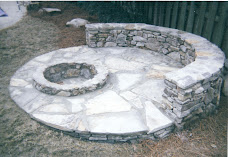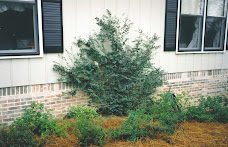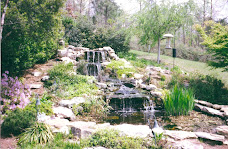Tuesday, February 3, 2015
Small walls have their place.
Posted by
themanfromearth
at
9:23 PM
0
comments
![]()
Labels: stone work, walls
Saturday, August 16, 2014
Flagstone Patio Construction in Progess
I'm definitely one to be easily amused as I get excited about the look of a patio coming together about as much as a finished one. This patio is a Summer project I'm doing in Vincent, Alabama. I'll be using polymeric sand in the joints which is a technique I'm growing very fond of for certain applications. The project includes a waterfall and several stack walls, the fire pit and benches and a couple other patios on the property.
Here is a picture of the work a little further along. I forgot to mention that I built a waterfall on the property as well, which you can see in the foreground. Anyway, a more completed picture will be coming soon....busy, busy, busy! (click on pictures to get a larger, better view)
Posted by
themanfromearth
at
4:32 PM
1 comments
![]()
Friday, January 24, 2014
Stone Work at Hoover, Alabama Catholic School
I was very careful in my placement of stone and that I held the trowel properly, mostly as a means of avoiding getting the back of my hand smacked with a nun's ruler.
Posted by
themanfromearth
at
4:44 PM
3
comments
![]()
Brown Stone Mail Box
Posted by
themanfromearth
at
2:58 PM
0
comments
![]()
Labels: stone mail box, stone work
Tuesday, January 21, 2014
Winter Watering Can Help Your Landscape Plants Thrive
Tonight, the low temperature will hover in the upper teens. On the surface, that doesn't seem to pose a detrimental threat to most of our plants we have growing in the Central Alabama, USDA zone 7B. Concerns, however, arise from the fact that this approaching cold front is not preceded by a rain event. A couple of weeks ago our area had temps in the low teens to upper single digits, but, as typically is the case, there was a significant rainfall that occurred just before the front moved in. I'm of the opinion that our plants may have been in better shape heading into that colder weather than we are for this one simply because we haven't had rainfall in our area for a week or more. In short, plants that have had the benefit of rainfall or watering will hold up better against the cold than plants that are dry. The roots, stems and leaves of dry plants are more likely to suffer from the dessication that bitter cold can create than those that are hydrated. It's worth the time and effort....ummm, and the discomfort, to be sure your plants are not dry going into a extreme cold event. Believe me, I know, as I was hand watering this evening in freezing weather with 40 mph wind gusts. Certainly, most plants in our area won't perish with temps only dipping into the high teens, but there are some specific categories of plants that would benefit: 1. Plantings that have been in the ground less than a year. 2. Plants with a zone hardiness rating at or below what your zone is for your specific area. 3. Herbaceous plants such as pansies, evergreen ferns, etc.
Posted by
themanfromearth
at
8:19 PM
2
comments
![]()
Labels: landscape tip
Wednesday, November 20, 2013
Hodge Podge Stone Bench
Have you got a few cinder blocks or old bricks out back behind the shed? Been collecting some stones from the side of the road? Willing to do a little wheeling and dealing with your local nurseryman for the small pile of 10 or 15 pieces of flagstone? Maybe pick up 3 or 4 bags of mortar mix after you next stop at Home Depot or Lowe's? Hey, you've just put together a neat little sidewalk bench!
plants in photo: (left) ivy in container, (right) rosemary
Posted by
themanfromearth
at
8:56 AM
0
comments
![]()
Labels: bench seating, stone work
Tuesday, November 19, 2013
Outdoor Fireplace Using Veneer Cast Stone
Posted by
themanfromearth
at
8:50 PM
3
comments
![]()
Labels: outdoor fireplace, stone work
















































